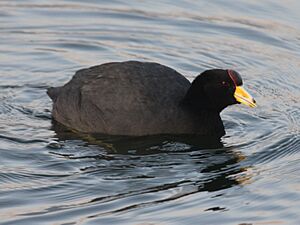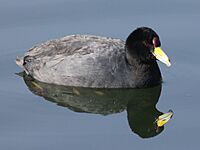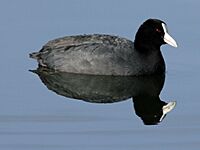Andean coot facts for kids
Quick facts for kids Andean coot |
|
|---|---|
 |
|
| at Otavalo, Ecuador | |
| Conservation status | |
| Scientific classification | |
| Genus: |
Fulica
|
| Species: |
ardesiaca
|
 |
|
The Andean coot (Fulica ardesiaca) is a type of bird that lives in South America. It's also called the slate-colored coot because of its gray color. This bird belongs to a family called Rallidae, which includes rails and gallinules. You can find Andean coots in countries like Argentina, Bolivia, Chile, Colombia, Ecuador, and Peru.
Contents
What is an Andean Coot?
Scientists group living things into different types. The Andean coot has two main groups, called subspecies. Their scientific names are F. a. ardesiaca and F. a. atrura.
For a long time, scientists debated how these groups were related. At one point, they thought these coots were part of the American coot family. Now, most scientists agree they are their own species. Some still wonder if the two subspecies might actually be separate species.
How to Identify an Andean Coot
The Andean coot is a medium-sized bird, about 40 to 43 centimeters (16 to 17 inches) long. It comes in two different color forms, called morphs. Both morphs are mostly a dark gray color. Their heads and necks are usually even darker, almost black.
One color morph has a bright yellow beak. The tip of its beak might be a lighter yellow or even green. It also has a deep reddish-brown shield on its forehead. Its legs and feet are green.
The other color morph has a white beak. Its forehead shield can be white or orange-yellow. This morph has gray legs and feet. Both subspecies have white tips on some of their wing feathers.
Where Andean Coots Live
The Andean coot lives in the Andes Mountains of South America. The F. a. ardesiaca subspecies is found from northern Peru down to northern Chile and northwestern Argentina.
The F. a. atrura subspecies lives from southern Colombia through Ecuador to northern Peru. It also lives along the coast of Peru.
These birds prefer large lakes with lots of plants growing in the shallow parts. They can also be found in lakes with fewer plants, or in ponds, marshes, and rivers. Coots with red forehead shields are often found in lakes with many plants. Those with white forehead shields are more common in higher, less vegetated lakes.
The F. a. ardesiaca subspecies lives at elevations between 2,100 and 4,700 meters (6,900 to 15,400 feet). The F. a. atrura subspecies lives between 2,200 and 3,600 meters (7,200 to 11,800 feet) in Colombia. It lives at lower elevations in Ecuador and Peru.
How Andean Coots Adapt
Andean coots that live high in the mountains have special bodies. They have adapted to places where there is less oxygen in the air. Their muscles have more tiny blood vessels, called capillaries. This helps them get enough oxygen even at high altitudes.
Andean Coot Behavior
How Andean Coots Move
Andean coots sometimes move from one place to another during different seasons. However, scientists are still studying exactly where and when they move.
What Andean Coots Eat
The Andean coot mostly eats water plants. A common plant they eat is Chara, especially in high-altitude lakes. They also eat plants like Myriophyllum and Elodea.
They find food by diving underwater, sometimes as deep as 5 meters (16 feet). They also walk on top of floating plants to find food. When they are not breeding, they often gather in groups. They may even feed alongside other types of coots.
Andean Coot Breeding Habits
The breeding season for Andean coots changes depending on where they live. They can lay eggs at any time of year. However, most eggs are laid during the dry season, usually in July and August.
Andean coots are monogamous, meaning they have one partner. When they are breeding, they become very protective of their territory. It's common to see mixed pairs, where one bird is a red-fronted morph and the other is a white-fronted morph.
They build their nests among reeds or on floating plants. Most often, a female coot will lay four or five eggs in a clutch.
Andean Coot Sounds
The usual call of the Andean coot is a low "churr" or a harder "hrrp." They often repeat this sound. Female coots make a soft "chitter" sound.
Andean Coot Status
The IUCN (International Union for Conservation of Nature) has looked at the Andean coot. They have listed it as a species of "Least Concern." This means it is not currently in danger of extinction.
The Andean coot lives across a very large area. However, scientists don't know exactly how many there are or if their numbers are changing. No immediate threats to the species have been found. In some places, they are very common and can even be seen in groups of thousands.
Gallery





